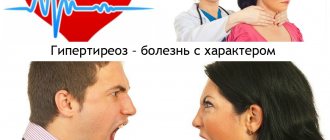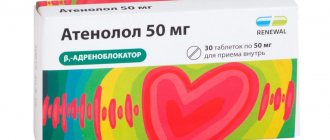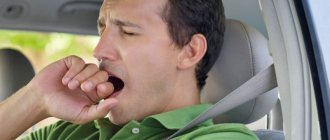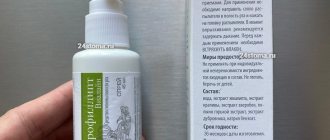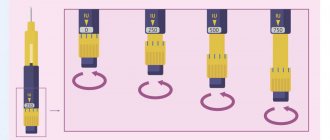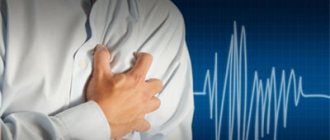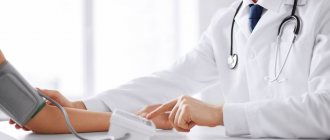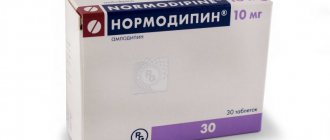First aid for tachycardia
The normal heart rate (HR) for a healthy adult is 60–80 beats per minute. To calculate your heart rate, you need to place the index and middle fingers of one hand on the wrist of the other and count the pulse rate for 15 seconds, then multiply the resulting number by 4.
If the heartbeat exceeds 90 beats, tachycardia begins. However, not every attack requires calling a doctor. For example, physiological (natural) causes of increased heart rate go away on their own if the provoking factor is eliminated - reduce physical activity, stabilize the emotional state, quit smoking, etc.
Pathological variants of tachycardia begin for no apparent reason and are accompanied by symptoms of oxygen starvation, decreased blood pressure and a feeling of fear. This condition can stop on its own, but in some cases an attack of tachycardia occurs due to serious pathology (heart or respiratory failure, hypertensive crisis). And then the rhythm of the heart can only be adjusted in the hospital.
Disruption of the normal heart rate (HR) can lead to serious complications such as:
- heart attack;
- stroke;
- acute heart failure;
- thrombophlebitis;
- injuries resulting from fainting.
An attack of tachycardia for no apparent reason requires a visit to the doctor, even if the episode of increased heart rate goes away on its own
What to do during an attack of tachycardia
- 1
Take a horizontal position. This will take the load off the heart and blood vessels. - 2
Release the chest and neck - unfasten the buttons, loosen the collar, remove the tie. Tight clothing restricts breathing, so the pressure needs to be loosened. - 3
Place a pillow under your neck. Throwing back the head can cause circulatory problems, which is unacceptable in conditions of tachycardia. - 4
Provide fresh air flow. When the heart rate increases, the body experiences oxygen starvation, so an open window can alleviate the condition. - 5
Drink a glass of cold water in small sips. Hot drinks, coffee or strong tea are prohibited, and douse yourself with cold water. - 6
Cool your face - for example, place a towel soaked in cold water on your forehead and temple areas. - 7
Perform breathing exercises. A cycle of repeating slow, deep breaths, holding your breath for 5 to 8 seconds, and exhaling slowly can slow your heart rate. - 8
If signs of panic appear, you should take a sedative. - 9
If an attack of tachycardia does not occur for the first time, you should take antiarrhythmic drugs prescribed by your doctor.
For tachycardia at a young age, massage of the neck and back of the head is acceptable. This method is contraindicated for the elderly due to the high risk of heart attack and stroke.
When to call the doctor
If the tachycardia is caused by a serious heart pathology, the first aid measures described above may not be sufficient. If tachycardia does not go away within 15–20 minutes, especially while taking antiarrhythmic drugs, you should immediately call an ambulance.
Other reasons to call a doctor
- Heart rate is 120 beats per minute or higher.
- Intense pain behind the sternum, which is accompanied by pallor, sweating, fear of death and a burning sensation spreading to the left arm, lower jaw or abdomen.
- Tachycardia is accompanied by severe headache and a feeling of numbness in the limbs or half of the face.
- The attack occurred during pregnancy.
Symptoms
The presence of clinical symptoms of sinus tachycardia depends on the degree of its severity, duration, and the nature of the underlying disease.
With sinus tachycardia, subjective symptoms may be absent or minor: palpitations, discomfort, a feeling of heaviness or pain in the heart area.
Inappropriate sinus tachycardia can be manifested by persistent palpitations, a feeling of shortness of breath, shortness of breath, weakness, and frequent dizziness. Fatigue, insomnia, decreased appetite, decreased performance, and worsened mood may occur.
The degree of subjective symptoms is dictated by the underlying disease and the sensitivity threshold of the nervous system. In case of heart disease (for example, coronary atherosclerosis), an increase in the number of heart contractions can cause attacks of angina pectoris, worsening the symptoms of heart failure.
With sinus tachycardia, there is a gradual onset and end. In the case of severe tachycardia, symptoms may reflect disturbances in the blood supply to various organs and tissues due to a decrease in cardiac output. Dizziness and sometimes fainting appear; with damage to cerebral vessels - focal neurological disorders, convulsions. With prolonged tachycardia, there is a decrease in blood pressure (arterial hypotension), a decrease in diuresis, and coldness of the extremities is observed.
Prevention of tachycardia
Since tachycardia itself is not a disease, there is no specific prevention for this condition. Primary preventive measures consist of maintaining a healthy lifestyle, daily routine and proper rest - that is, the same as for the prevention of any heart failure.
Secondary preventive measures that should be followed in case of already established heart pathology imply more serious lifestyle adjustments, drug therapy prescribed by a doctor (if necessary, surgical interventions), as well as regular medical examinations.
Review of drugs for tachycardia
Medications are prescribed to normalize the pulse and control heart contractions. When choosing the most effective remedy, the doctor takes into account the degree of progression of the disease, the presence of other pathologies and contraindications. Therapy is carried out under outpatient supervision of a specialist.
When the heart rate increases, it is necessary to take suitable antiarrhythmic drugs, which are divided into several groups. Drug therapy is prescribed individually for each patient.
Membrane stabilizing
The body’s reaction to membrane-stabilizing drugs is that the heart begins to beat more slowly. This is due to a disruption in the transport of potassium, sodium and calcium ions, which is achieved under the influence of the active components included in the preparations. In this case, there is a decrease in excitability and a weakening of contractions.
Among the most effective remedies for high pulse membrane-stabilizing action are:
- " Metostabil " (oral pulse tablets) - the dosage is gradually increased from 125-250 mg until a therapeutic effect is obtained. It is not recommended to take during pregnancy, lactation, or with liver and kidney failure.
- “ Etatsizin ” - you need to take tablets for tachycardia 50 mg three times a day. If the expected result is not achieved, the dosage is increased. You can take no more than 300 mg per day, divided into 3 doses. The drug is not recommended for myocardial hypertrophy, in the post-infarction state and for children under 18 years of age.
- “ Novocainamide ” - drink 0.25-1.00 g every 3-6 hours. If there is no result, the dosage is increased to 3 mg per day. Contraindications include heart failure, myocardial infarction and renal failure.
Beta blockers
Medicines developed on the basis of substances that block adrenergic receptors. Such drugs are used for hypertension because they affect the functioning of the nervous system. Beta blockers relieve pain in the heart and protect against atherosclerosis.
The action of the drugs is aimed at reducing the myocardial oxygen demand to reduce heart rate and support coronary blood flow. The active substances included in the composition prevent the formation of blood clots and the progression of the pathological process. The use of beta blockers reduces the incidence of heart attacks and reduces the likelihood of sudden death.
Cardiac glycosides (CG) to reduce heart rate
The pharmacological effect of cardiac glycosides is to change the basic functions of the heart. Under their influence, heart contractions increase, which leads to an increase in the volume of blood thrown into the aorta. The heart rate slows down, which increases blood flow to the heart ventricles.
The effect that SGs have on blood pressure is variable. With normal blood pressure levels, no changes are observed with the use of cardiac glycosides. The drugs have a pronounced calming effect on the central nervous system (CNS).
Cardiac glycosides that are prescribed for tachycardia:
- Sinus bradycardia in children: root causes of development, ECG signs, treatment
- "Digoxin";
- "Strophanthin";
- "Korglikon".
Cardiac glycosides
Among the drugs for the treatment of complex heart diseases, there are those aimed at reducing the rate of myocardial contraction. These are the so-called cardiac glycosides. They have a strong effect; their properties can relieve swelling in the legs, eliminate wheezing and shortness of breath.
These drugs are also used in the treatment of tachycardia at normal pressure. Their main goal is to increase the volume of blood released into the vessels and reduce heart rate. Cardiac glycosides also have a powerful diuretic effect.
List of drugs:
- "Korglikon".
- "Celanid".
- "Digoxin".
- "Strophanthin".
Medicines 1 and 4 are fast-acting. The effect occurs within 10 minutes when administered intravenously. In turn, points 2 and 3 refer to prolonged ones (with a long-lasting effect that can last about a day).
How to reduce your pulse here and now?
A rapid heartbeat can occur at the most inopportune moment, so before the ambulance arrives, it is necessary to carry out a number of procedures. First of all, drugs for tachycardia and normal blood pressure with sedative properties will help relieve sudden attacks. A noticeable effect will occur within 20 minutes. It is advisable for the patient to take a supine position in a room with good access to oxygen. If the situation occurred in a public place with a large crowd of people, you need to take the patient aside.
Other required actions:
- unbutton or remove clothing;
- take a comfortable position and try to regulate your breathing;
- wash your face with cold water.
Drug therapy alone is not enough to eliminate the symptoms of tachycardia
If the room where the tachycardia attack occurred is too hot, the person may lose consciousness, and in this case, you will have to rely on the help of others who may not know how to act. To prevent this from happening, try to help yourself. If you feel short of breath, take off your outer clothing and go to a well-ventilated place. The cause of such attacks may be a decreased level of hemoglobin. Such people are recommended to take various vitamins and foods rich in iron.
Remember, medications for tachycardia at normal blood pressure may not always be at hand, especially if you have not yet consulted a doctor or this problem has overtaken you for the first time, but you need to be able to help yourself. After you have unbuttoned your clothes and moved to a comfortable place, take a deep breath and hold your breath for a few seconds. It is best to combine this exercise with immersing your face in ice water.
Before the ambulance arrives, in the absence of any means, you can resort to radical methods. For example, induce vomiting. People who regularly suffer from this disease are advised to master the basics of neck massage in order to independently eliminate the attack by massaging the carotid sinus. The procedure is simple, but requires experience (in order not to harm yourself, clarify this issue with your doctor at your next consultation).
Suitable remedies that will relieve symptoms are: “Persen” and “Novo-Passit”. They are relatively harmless as they contain ingredients of plant origin. Before purchasing this medication, consult your doctor to determine the correct dosage for all cases.
Physiological and pathological tachycardia
Depending on the causes of occurrence, physiological and pathological tachycardia are distinguished.
Physiological tachycardia occurs during emotional, physical stress, high temperature and humidity, being in hot and stuffy rooms, abuse of tonic drinks - strong tea, coffee, energy drinks, taking certain medications, smoking or drinking alcohol.
In healthy people, physiological tachycardia is an adaptive mechanism and, when the external stimulus is removed, the heart rate returns to normal within 5 minutes.
Pathological tachycardia occurs in cardiovascular, endocrine, acute infectious, oncological and other diseases and accompanying conditions - dehydration, large blood loss, shock conditions, pain syndrome, etc. - or when the functioning of the autonomic nervous system is disrupted.
Thus, tachycardia at rest is most often a symptom of some disease and requires medical examination.
With tachycardia, the heart works under increased load and does not have time to fill with blood in the required volume, the blood supply to all organs deteriorates, and oxygen starvation develops.
The kidneys, organs of vision and gastrointestinal tract, central and peripheral nervous systems suffer, and the course of existing diseases is complicated.
The heart muscle gradually wears out, which can result in heart failure. In addition, there is a life-threatening type of tachycardia, so a visit to the doctor cannot be postponed.
Blood thinners for heart problems
Separately, it is worth considering blood thinners, which are prescribed to prevent the formation of dangerous blood clots. These medications include antiplatelet agents and anticoagulants, which have the side effect of increasing the risk of bleeding. If a doctor prescribes one of these drugs to a patient, this means that great care must be taken with any injury, surgery, or even dental procedures.
Antiplatelet agents
These drugs work by directly affecting the function of platelets in the blood. Platelets are special cells that help stop bleeding by sticking together and forming a clot.
List of drugs with antiplatelet action:
- clopidogrel (Plavix);
- prasugrel;
- tirofiban (aggrastat);
- dipyridamole.
How to relieve an attack of tachycardia?
Unbutton your clothing collar, open a window or balcony, inhale deeply and exhale very slowly; breathe like this for 5-10 minutes. Then hold your breath and, as it were, “push” the air into the lower abdomen - this stimulates the vagus nerve, as a result of which the heartbeat will slow down;
Take Corvalol or Valocordin: dissolve 15-20 drops of the drug in half a glass of water at room temperature;
Wash your face with cold water, lie down on a high pillow, place a towel soaked in cold water on your forehead, try to relax;
Close your eyes and simultaneously press on your eyeballs for 2-3 minutes: press for 10 seconds, break for 10 seconds;
Find the right carotid artery (immediately under the jaw, at this point it connects to the cervical artery) and gently, without pressure, massage it. This technique also stimulates the vagus nerve and slows the heart rate.
If the condition does not improve, the heart rate does not decrease, dizziness appears, a feeling of shortness of breath, darkened vision, call an ambulance.
Thyrostatic drugs
People suffering from endocrine diseases need appropriate medication. If you have tachycardia and normal blood pressure, but have a thyroid problem, you need to take medications that lower hormone levels. Endocrinologists recommend drinking iodine. It is its lack that leads to excessive secretion of hormones in the thyroid gland. To solve the problem, as well as to improve the absorption of iodine, medications such as Tyrozol, Propicil and Mimpar are prescribed.
Reduce the intensity of electrical impulses entering the heart
Endocrine diseases are very unpleasant, as they lead not only to tachycardia, but also to:
- frequent mood changes;
- irritability;
- depression.
Therefore, it is important to take medications on time, as well as take advantage of all the benefits of preventive measures.
